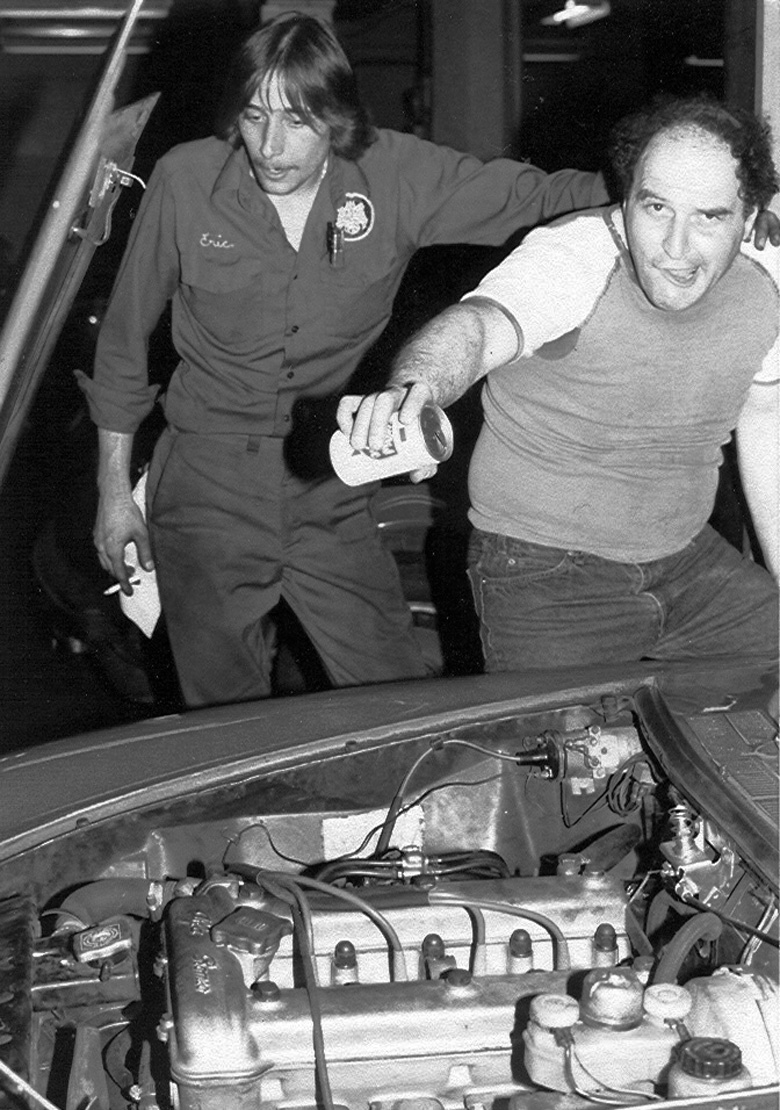
Alfa Amore? The reader who submits the funniest caption gets a free copy of The Last Open Road. Please send caption to vack@cox.net.
Story by Burt Levy
Hello again!
As you may recall, we last left our story of “Burt Levy, Racing Driver Semi-Extraordinaire” somewhere in the dusty, paint fume-infused interior of Loeber Motors third-floor body shop on Chicago’s trendy/money-spendy near north side. That’s where I found my soon-to-be-beloved and not-so-nearly totaled (no matter what the insurance company was led to believe) 1974 Alfa Spider racecar.
You may also recall that I cut my racing teeth (along with many other parts of my anatomy) on a succession of self-wrenched and occasionally self-mutilating Triumph TR3s. Mind you, much of the distress and damage was self-inflicted, seeing as how I knew virtually nothing about racing (except that I dearly, desperately wanted to do it) and I was a terrible mechanic. Not to mention that the trick parts and go-faster goodies necessary to turn a Triumph TR3 into a decent racecar had to be out-sourced from local specialist firms whose owners I can only assume had yachts on Lake Michigan and lovely summer homes up in Wisconsin.
The one thing I was long in was enthusiasm…Boy, was I ever long on enthusiasm!
During my first three racing seasons I created, then survived, a succession—no, make that a virtual plague—of Frankenstein-monster Triumph TR3s that always seemed to go faster and faster for shorter and shorter periods of time. I qualified on the front row many times, but only managed single first-place trophy. And that was for a lousy 5-lap grid race at Milwaukee’s gnarly old State Fair Park. Better known as “The Milwaukee Mile,” it was converted to a road course, silk purse-into-sow’s-ear style, with the addition of a narrow and choppy little infield section. I recall Turn One was like sweeping off a wide, smooth superhighway onto someone’s driveway. Through a gate in a chainlink fence, I might add…
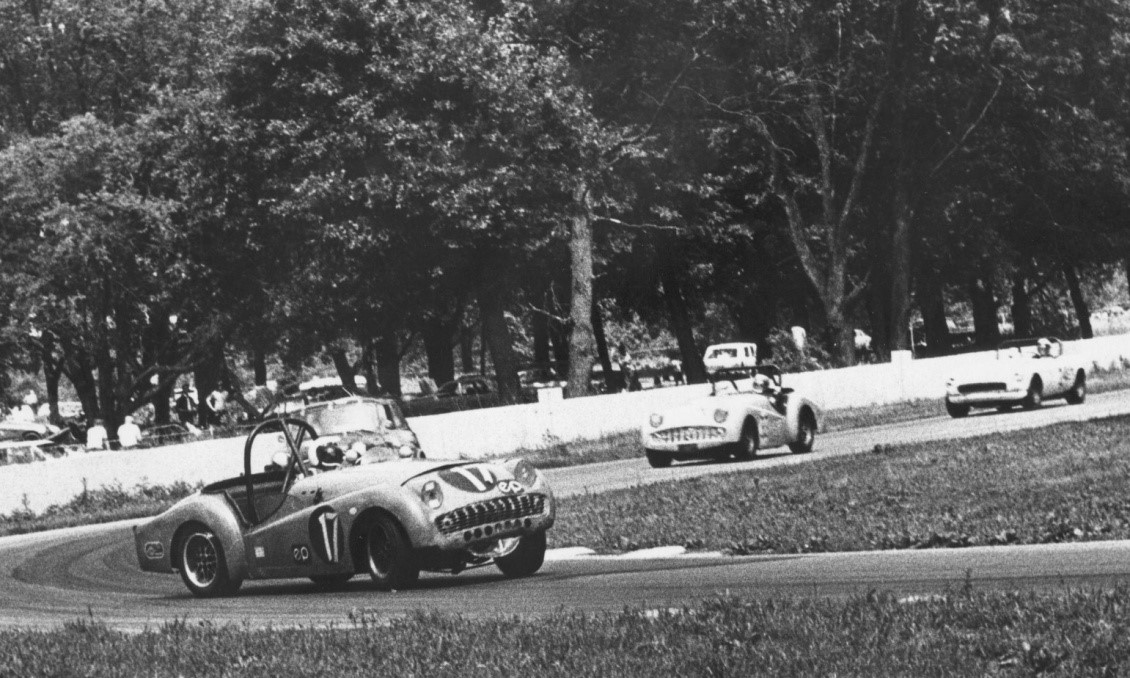
A less-than-sublimely sideways BS Levy explores the past-the-limit handling (sic) of his self-wrenched British sled.
No question my TR3’s were brilliantly conceived, but thanks to a combination of ineptness, inexperience and idiocy, they managed to amass a truly disheartening string of fractures, blow-ups and breakdowns. My friend Jimmy Sacco took pity on me, and invited me to co-drive his Spitfire…and damn if we didn’t win the blessed race! And then an extremely enthusiastic Mellow Motors customer whose wife wouldn’t let him race allowed me to prepare and campaign his somewhat shopworn Datsun 240Z in the Midwest Council’s Showroom Stock class. It was so rusty that I recall the floorboards undulated menacingly under heavy braking. I backed into a win with that heap as well. And then there was my tragicomic attempt at building a world-beater TVR 2500M out of a donor vehicle that turned out, in the end, to be a stolen car. The statute of limitations has long since run out on that particular escapade, and you can read all about it (“The Car That Never Was”) in my A Potside Companion short-story anthology.
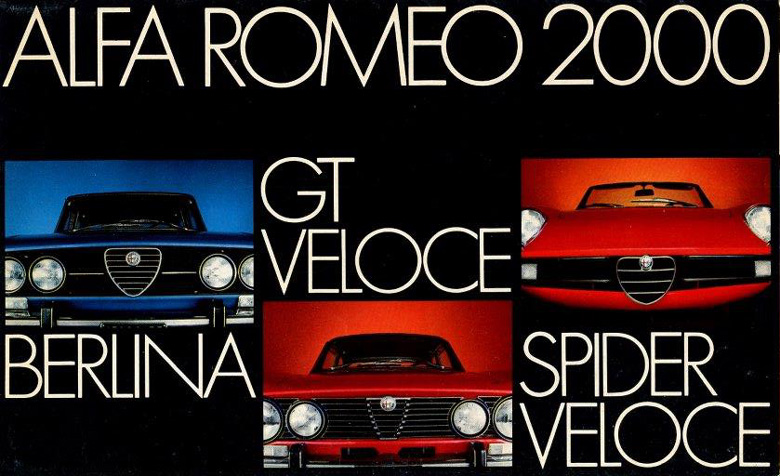
Alfa supplied its dealerships with lovely cars and hand-out brochures, but we had to generate the enthusiasm.
But fast-forward a year-and-a-half and I’m behind a sales desk at Loeber Motors and doing a better-than-reasonable job selling Volkswagens, Alfa Romeos, Mercedes-Benzes and even a few Rolls-Royces off the showroom floor. And making some semi-serious money for the first time ever in my so-called “automotive career.” Which allowed me to purchase, at a very reasonable price, the Verde Pino (Pine Green), dented-but-not-daunted/totaled-but-far-from-terminal 1974 Alfa Romeo Spider that the previous owner’s insurance company was only too happy to get off its balance sheet.
Thanks to my gauntlet-run three-year apprenticeship as a sports car shop owner (I know, I know: shop owners are supposed to have apprentices, not be apprentices, but we always did things a bit differently at Mellow Motors) I could now look at various mechanical bits and pieces and actually understand how they worked! And sometimes even how they needed to be fixed! I think it’s fair to say I’d attained my B.A. (as in “Barely Adequate”) as an automotive technician.
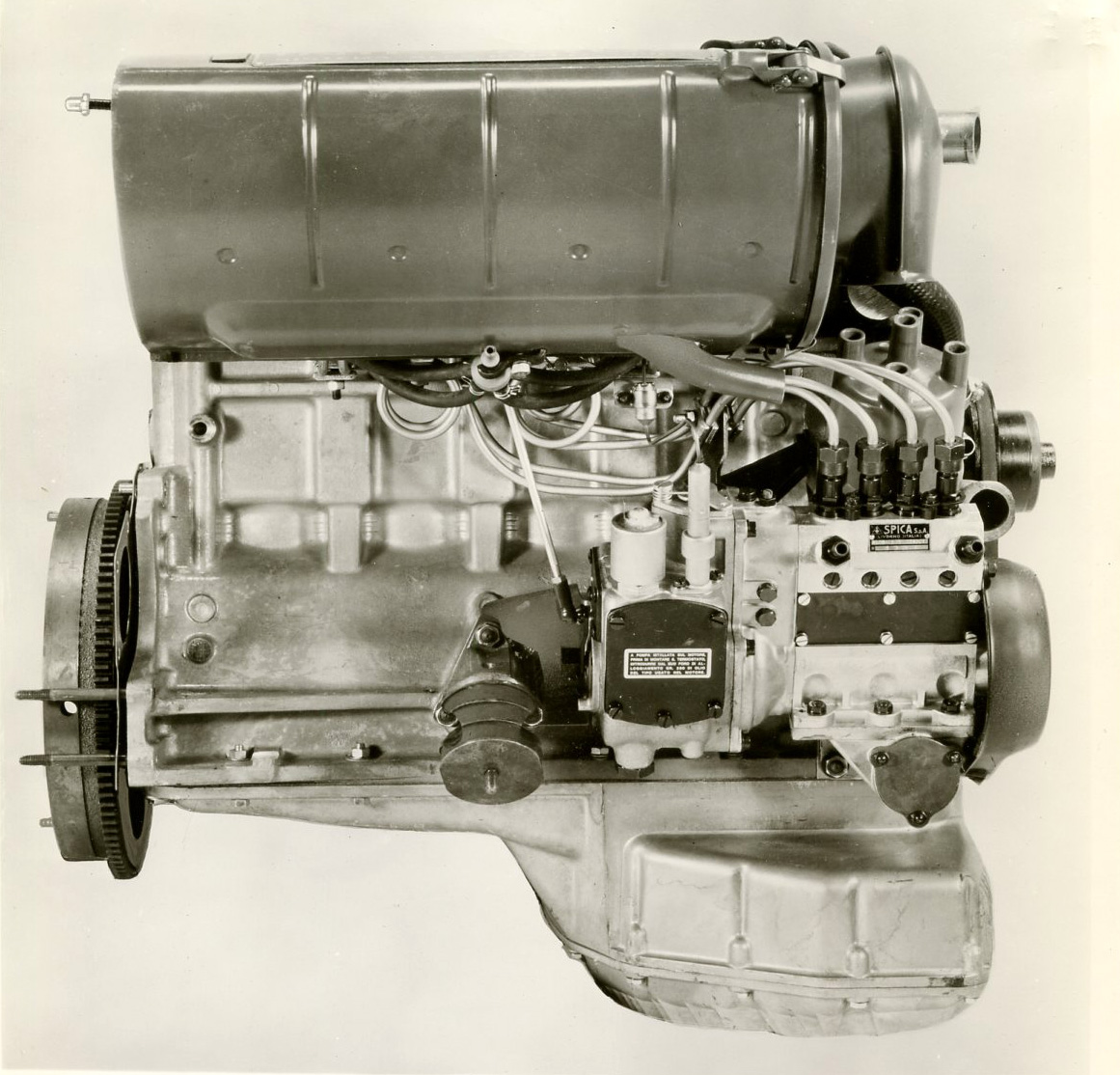
Alfa motore showing the oft-maligned but more often misunderstood/mis-adjusted SPICA fuel injection fitted to US models.
Now to be honest about it, we were mostly a British Car shop at Mellow Motors (with some rusted-out VW Beetle work thrown in to keep both the wolf and the landlord from the door when things were slow) and we hadn’t really been intimate with many Alfa Romeos. I do recall that we fiddled with every threaded coupling and set-screw we could find on the injection pump of a customer’s 1750 Spider Iniezione (like until all it would do was fart through the exhaust or backfire through the air filter), but all of my real ace-mechanic friends adored—nay, even worshipped—Alfa Romeos. Even the guys who worked on Ferraris for a living. In fact, they called them “the poor man’s Ferrari.”
So I had the Alfisti bug already germinating inside when I acquired that ’74 Spider.
After the Loeber body shop had done a cheap, quick and dirty, Friends-and-Family-priced pound-out and slathered on about eight pounds of Bondo and a pint or two of Pino Verde paint, I drove it around the block a few times. And it felt pretty damn good! Then I brought it into the service shop after hours so we could poke around a bit and put it on the lift. That’s when I fell desperately and even terminally in love with Alfa Romeos. Sure, they were beautiful to look at. Sure, they made that deep-gurgling, hollow-and-reverberating Alfa sound. Sure, they were supple, feline and even feminine over the road (rather than jaunty, canine and masculine like most of the popular British sports cars). But the real joy was in seeing all the wonderful parts and engineering that made it happen…
Like the back axle, for example. The center section was cast aluminum for lightness and webbed for strength! Beautiful! And with a ZF clutch-type limited slip differential (“Positraction” to you Corvette types) as standard equipment from 1972 on! Did you hear me there in the back row: AS STANDARD EQUIPMENT! And, thanks to the STANDARD 0.79 overdrive fifth gear, a tightly wound 4:56 ring-and-pinion ratio. That’s drag strip stuff! And lookee here: beautiful cast alloy wheels and ATE disc brakes at all four corners…STANDARD! Plus it had coil springs instead of oxcart leafs like all the British sleds I knew. Only how do you control the roll and pitch and wind-up on a coil-spring rear end? Alfa’s answer was this strange-but-beautiful cast T-arm that controls axle tramp on acceleration and hard braking and locates the axle side-to-side as well (and puts the rear roll center about halfway to Jupiter…but that’s another story). By comparison, an Austin-Healey 3000’s rear axle looks like a blessed Franklin stove. And weighs as much, too!
The transmission was equally glorious, with five forward speeds (including the overdrive 5th mentioned above) in a beautifully ribbed aluminum case and bell housing. Ask your favorite Bugeye Sprite racer how many of the early, non-ribbed Sprite bell housings they’ve broken, and the answer will likely be: “all of them!” Plus the Alfa’s shifter sprouts right out of the box and stirs the ratios with wonderful feel and throws. Although second-gear synchro rings do tend to be a bulk-purchase item at Alfa Romeo dealerships and service shops…
Then we lowered it down and popped the hood to take an appreciative look at the motor. There is, quite simply, no more beautiful, graceful, well-engineered or elegantly symmetrical 4-cylinder sports-car motor on the planet. Or one that has, in its various guises, models, body styles and displacement variations, won more races. Alfa built their first-ever DOHC motor in 1914, and both their Grand Prix machines and their sports cars dominated European motor racing throughout much of the 1930s.
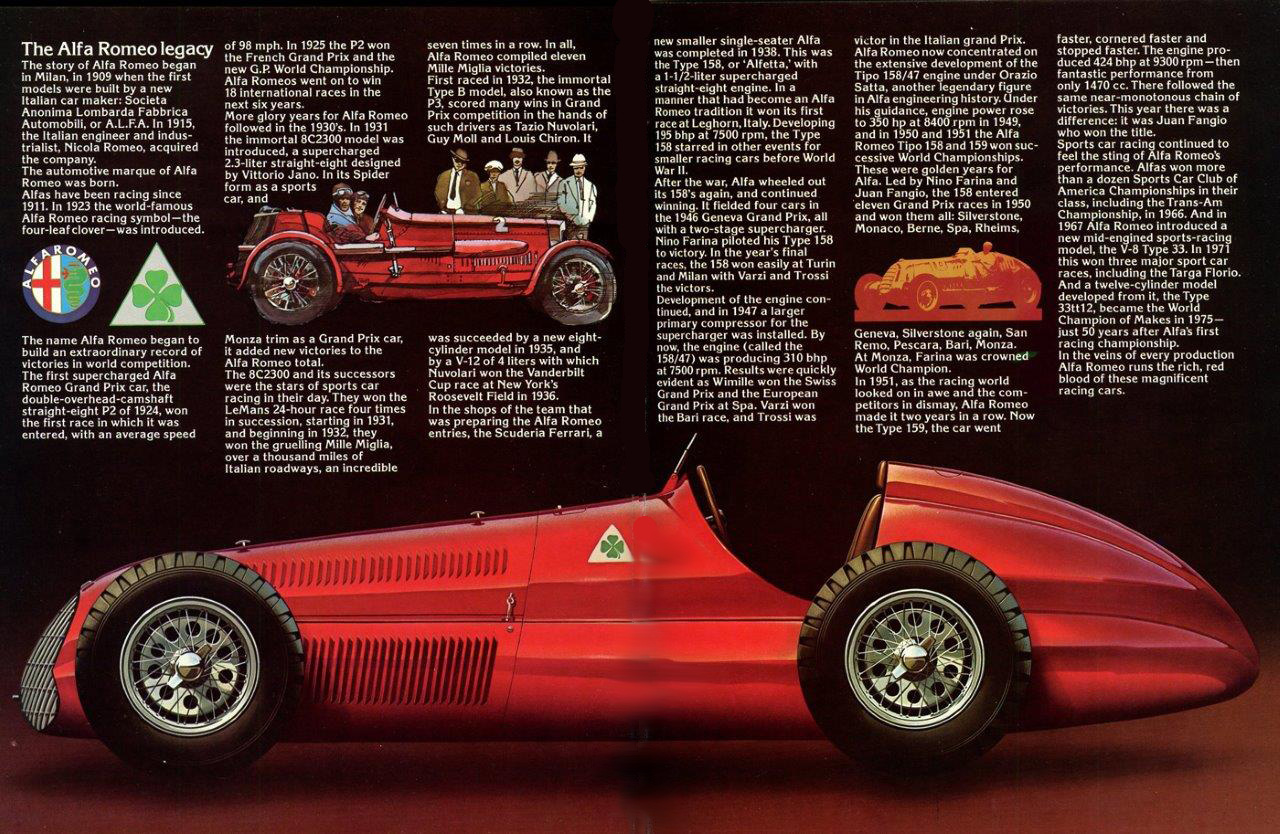
The immortal Alfetta 158/159. If Burt ever gets a movie deal for his books, he’s going have one and race it! He will not, however, be doing his own mechanical work…
And after the war, as well. In fact, the supercharged, 1.5 liter Alfa 158/159s so dominated the postwar Grand Prix scene that the championship was switched to Formula Two in order to provide some sort of competitive show for the spectators. And the motor in my soon-to-be-racecar Alfa was not just a distant relation, but a DIRECT DESCENDANT of those great and successful racing motors.
I mean, just look at the damn thing. It’s all aluminum…even the effing cylinder block!
OK, so I’m in love!
Smitten…
But you never know how a racecar is going to go until you put it on the racetrack (and, moreover, up against the cars it’ll have to run against!). My plan is to run it in the Midwestern Conference of Sports Car Clubs (our local and wonderfully user-friendly amateur sanctioning body) in Showroom Stock A, which means it can be a true dual-purpose car, doing street duty as necessary alongside a hopefully hectic racing schedule. Now the MCSCC rules wisely allow for certain, quite sensible modifications (aftermarket shocks and brake pads and a straight-through exhaust, for example) plus the usual and necessary safety gear like a roll bar, five-point driver harness, etc.

Burt opened so many of these orange Alfa parts boxes that his fingers looked like he’d been eating Cheetos.
So I order the appropriate goodies—anybody who tells you their rollbar “just bolts right in” has an amazingly optimistic outlook—and I get a deal through the Loeber parts department on a set of Koni adjustable shocks and Ferodo DS11 brake pads (damn the asbestos, they’re still probably the best I’ve ever encountered) and I’m scrounging around the Mercedes-Benz and Alfa totals up in the body shop looking for potential race tires. I find a set of extremely pristine Pirelli Cinturato CN36s off of a highly suspicious Mercedes burnout (“you say the cigarette lighter in your 280SE must’ve shorted out?”), and I make a deal for them because, well, mostly because the manufacturer’s name ends in a vowel and Pirelli has a great and noble racing history. Plus I’ve drooled over/lusted mightily after their famous pin-up calendars ever since puberty…maybe even before? Not to mention that aggressive, cross-hatch herringbone tread pattern looks kinda neat…
So we go to our first race and the car runs pretty good. But it kinda “squeegees” its way around corners and it doesn’t put the power down any better than the no-limited-slip Datsun Z-cars coming out of Blackhawk’s Carousel. Plus it’s not quite fast enough to run at the sharp end of the grid. It’s close, mind you. But we’ve obviously got work to do.
NEXT INSTALLMENT: We Start Winning Races (or: the fine, fuzzy line between “preparation” and “cheating”).

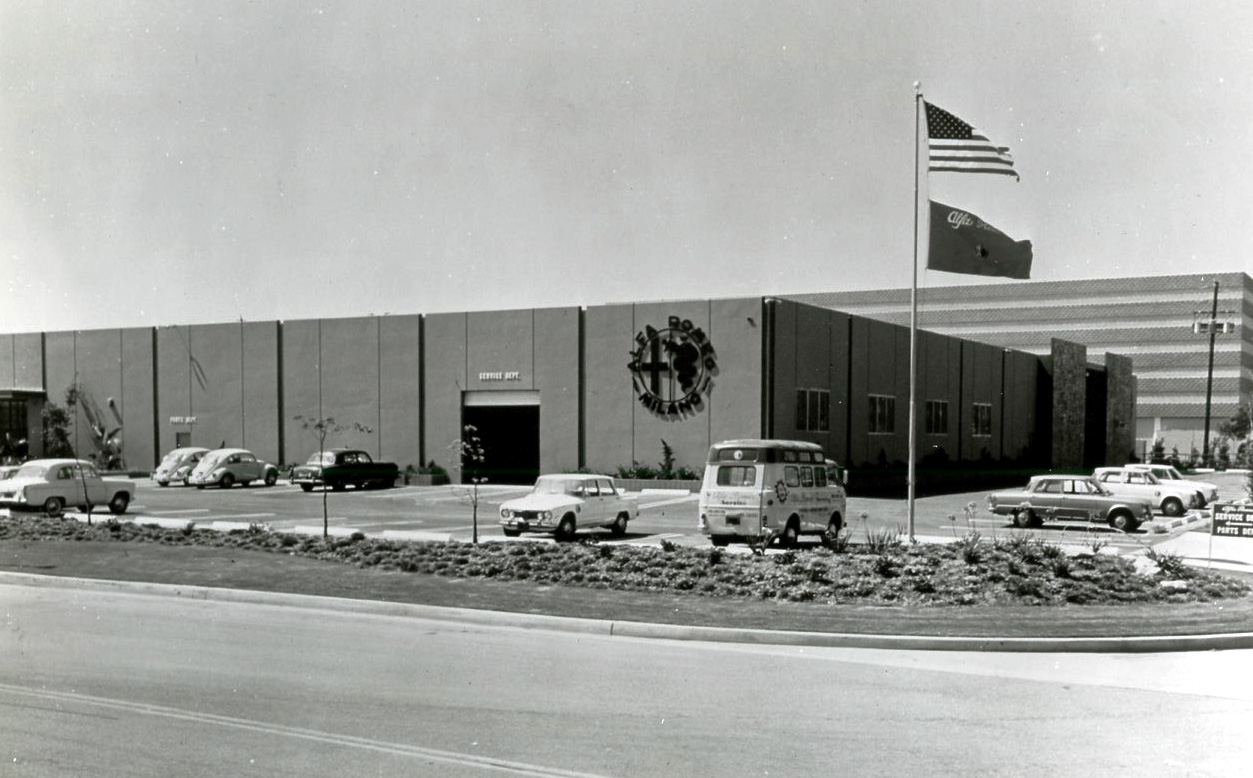
Having owners and tooled a Healey 3000 around Mosport in Canada , Burt is dead on with his comparison to a Franklin Stove
My GTV is a Viking stove……..
i christen thee synchro
Lively, enjoyable read.
Going from a TR 3 to an Alfa.
In 1957, my parents helped me buy a 1955 Healey 100. The 4 C with lots of torque. Having then been to university in 1962 I bought an MGTF 1250.
Also, at that time my sister had a TR-3.
Then when my real job sent me to Toronto in 1965 I had $1400 with which to buy a Porsche 356. On the way to check out a used one, there was a sports car dealer. Tried a used Alfa Giulietta Spider.
Bought it, and the difference in handling and braking from the Brit cars to the Alfa was a “Night and Day” improvement.
Plus comfort in the supple and well-controlled suspension. Even the wind-up windows was a huge improvement in comfort and convenience. Compared to opening the trunk to get out the side curtains and windows.
Enjoyed a number of Alfas as daily drivers since.
Then as “collector cars” in 2005 and 2006 bought a 62 Spider, a 63 Sprint and a 67 Super.
Because of my age sold them over that last couple of years.
Sigh,
BURT, I STILL REMEMBER THE ALFA GS4R ARTICLE YOU WROTE AND PHOTOGRAPHED IN OAK PARK. I STILL HAVE THE CAR LOVING IT 50 YEARS LATER. GREG MIHALIC
“Eric tried to restrain Mongo from setting the Alfa ablaze, but Mongo would not be stopped.”
Needs more “Juice”
I raced an iron-block ’59 alfa 2000 spider in e production in a few races–a wonderful place from which to watch the race instead of just sitting in the stands. several nuts held the windshield on and they were easy to get to. the exhaust pipe broke and for one race I ran a flex pipe side exhaust which sounded better than a birdcage Maserati; surprised the heck out of me! when it was traded in at Hoffman motors in Beverly Hills the evaluator said aside from the shocks being a bit soft it was the fastest 2000 he’d ever driven. and I never had a problem with those weird solex carbs either. it did have the worst seats of any car I can remember
“Alfas were supple, feline and even feminine over the road (rather than jaunty, canine and masculine like most of the popular British sports cars)”
That right there is the all the description you need about the difference between Italian and British cars.
Caption: “A young Andy Granatelli tests out his first formulation of what would later become known as STP.”
Burt, what better thing to bring together an Arab, a Jew, a Frenchman and a Chinaman but a shared love of owning/racing Alfa Romeo’s. Actually, Mike still hasn’t bought an Alfa because his girlfriend won’t let him, but he is a kindred Alfisti in spirit. Come to Watkins Glen in Sept and we’ll help you sell more of those lousy books.
Eight comments already, but as Member 59 of the TR Register (1955 TR 2), current owner of a 1974 Alfa Romeo Spider Veloce (The Alfatross, now green but originally white-ish), and of course a ham-fisted mechanic, I have to jump in. Never raced either, but yes, a contrast in engines. The TRs shared an iron block, and maybe more, with Ferguson tractors. I was fortunate to have a Ferguson dealer nearby in Abingdon, back in the day. I too love the Alfa Romeo four: a work of engineering art
6 drops of essence of terror,
5 drops of sinnester sauce,
And it’s alive!!!!!!!!!